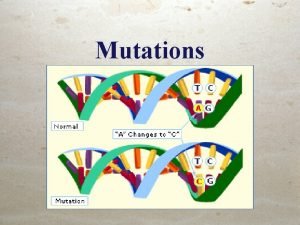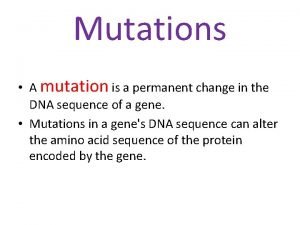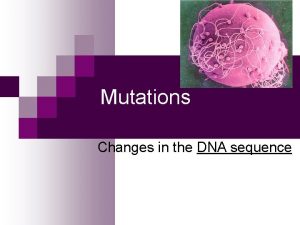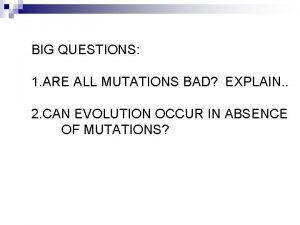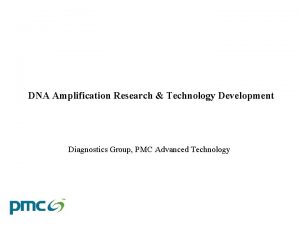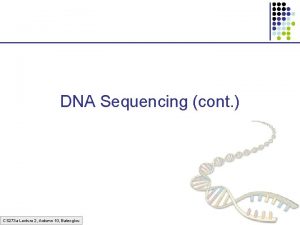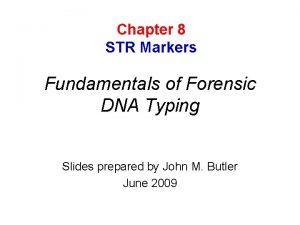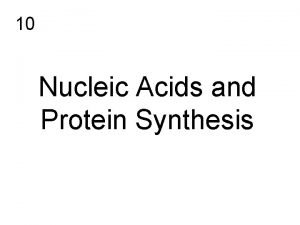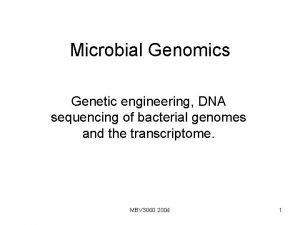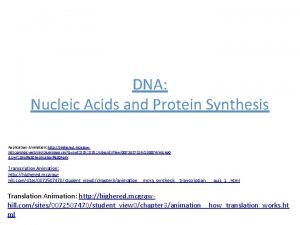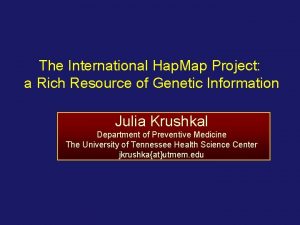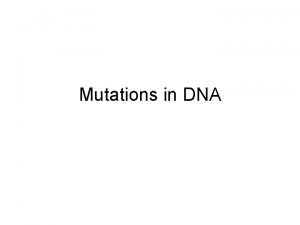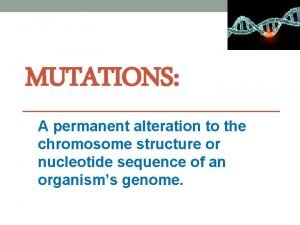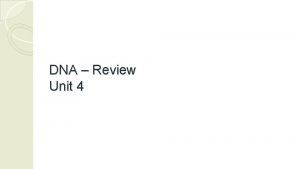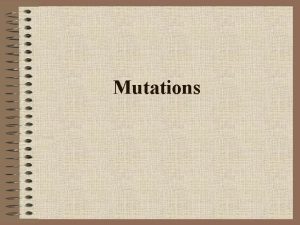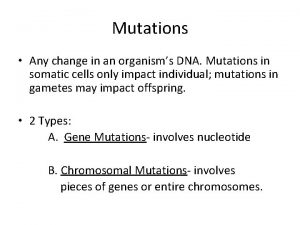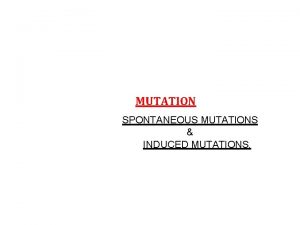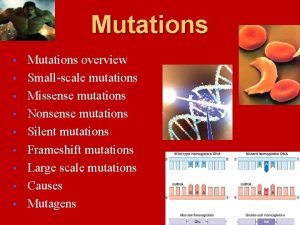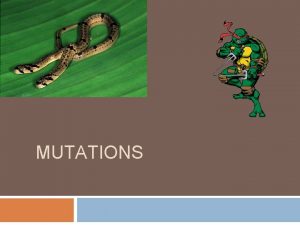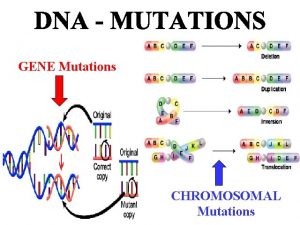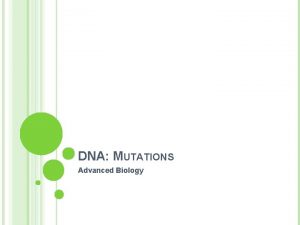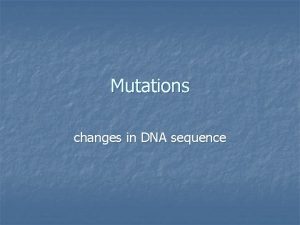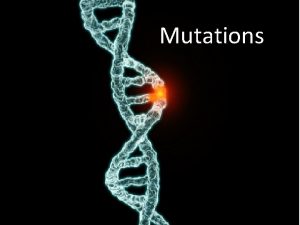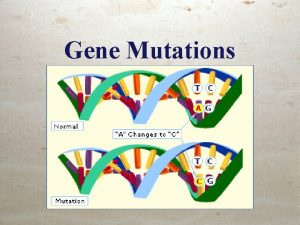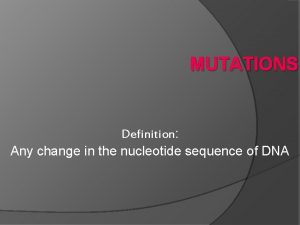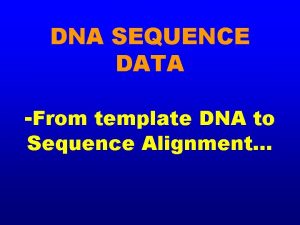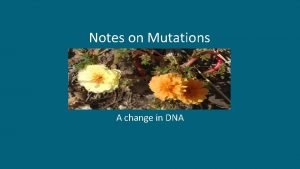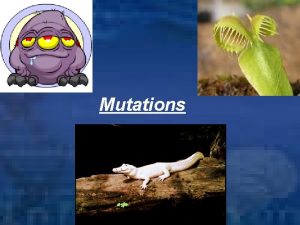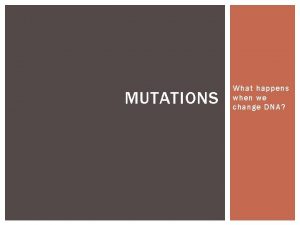Mutations Mutations Any change in DNA sequence is























- Slides: 23

Mutations

Mutations • Any change in DNA sequence is called a mutation. • Mutations can be caused by errors in replication, transcription, cell division, or by external agents.

Mutations • Mutations can be harmful. – Sickle Cell Disease – Cystic Fibrosis • Mutations can be beneficial. – Phenotypic (physical) changes – Flower color – Fur color

Mutations • Mutations can occur in both types of cells: – Body cells (muscle, skin, brain, bone, etc. ) – Gametes (Sex Cells – sperm or egg) Skin Cells Sperm Cell & Egg Cell

Mutations in body cells • If a body cell’s DNA is changed, this mutation would not be passed on to offspring. • Damage to a gene may impair the function of the cell. • When that cell divides, the new cells also will have the same mutation. • This can result in the cells growing and dividing rapidly, producing cancer.

Mutations in Gametes • Mutations that occur in the gametes or sex cells can be passed on to the offspring.

Kinds of Mutations • Mutations that produce changes in a single gene are known as gene mutations. • Mutations that produce changes in whole chromosomes are known as chromosomal mutations.

Gene Mutations • Gene mutations involving a change in one or a few nucleotides are known as point mutations because they occur at a single point in the DNA sequence. • Point mutations include substitutions, insertions, and deletions. • example: Sickle Cell Disease – one nucleotide is substituted for another

• Sickle Cell Disease causes the red blood cells to be deformed. The result is that they get stuck in the blood vessels, depriving tissues of oxygen, causing strokes, and blood clots.

Gene Mutations A point mutation is a change in a single base pair in DNA THE DOG BIT THE CAT. THE DOG BIT THE CAR. • A change in a single nitrogenous base can change the entire structure of a protein because a change in a single amino acid can affect the shape of the protein.

• Substitutions usually affect no more than a single amino acid.

Gene Mutations • The effects of insertions or deletions are more dramatic. • The addition or deletion of a nucleotide causes a shift in the grouping of codons. • Changes like these are called frameshift mutations.

Gene Mutations What would happen if a single nitrogenous base (letter) is deleted? THE DOG BIT THE CAT. THD OGB ITT HEC AT. • A mutation in which a single base is added or deleted from DNA is called a frameshift mutation.

• In an insertion, an extra base is inserted into a base sequence.

• In a deletion, a single base is lost and the reading frame is shifted.

Chromosomal Mutations • Chromosomal mutations involve changes in the number or structure of chromosomes. • Chromosomal mutations include deletions, duplications, inversions, and translocations. • Sometimes during mitosis or meiosis chromosomes break and then rejoin incorrectly, or just a piece breaks off for good.

Deletions involve the loss of all or part of a chromosome.

Duplications produce extra copies of parts of a chromosome.

Inversions reverse the direction of parts of chromosomes.

Translocations occurs when part of one chromosome breaks off and attaches to another. Copyright Pearson Prentice Hall

Causes of Mutations • Some mutations seem to just happen, perhaps as a mistake in base pairing during DNA replication. – These mutations are said to be spontaneous. • However, many mutations are caused by factors in the environment, such as radiation, chemicals, and even high temperatures. • Any agent that can cause a change in DNA is called a mutagen.

Significance of Mutations • Many mutations have little or no effect on gene expression. • Some mutations are the cause of genetic disorders. • Beneficial mutations may produce proteins with new or altered activities that can be useful. • Polyploidy is the condition in which an organism has extra sets of chromosomes.

Significance of Mutations • Mutations in body cells do not affect offspring. • Mutations in sex cells can be harmful or beneficial to offspring • Mutations that affect a single gene usually happen during replication • Mutations that affect group of genes or chromosome happen during meiosis (formation of eggs and sperm)
 Chromosomal mutation
Chromosomal mutation Permanent change in dna sequence
Permanent change in dna sequence Dna types of mutations
Dna types of mutations Inversion dna
Inversion dna Mutations in dna
Mutations in dna There isn't any chicken
There isn't any chicken Any to any connectivity
Any to any connectivity Seknder
Seknder Replication
Replication Bioflix activity dna replication lagging strand synthesis
Bioflix activity dna replication lagging strand synthesis Coding dna and non coding dna
Coding dna and non coding dna What are the enzymes involved in dna replication
What are the enzymes involved in dna replication Dna and genes chapter 11
Dna and genes chapter 11 Human dna sequence example
Human dna sequence example Str
Str Look at the dna sequence gaa-ttc-gca
Look at the dna sequence gaa-ttc-gca Sequence dna
Sequence dna Dna sequence
Dna sequence مشروع هاب ماب
مشروع هاب ماب Sickle cell anemia dna sequence
Sickle cell anemia dna sequence Permanent
Permanent A segment of dna has this sequence ata gca cat gta
A segment of dna has this sequence ata gca cat gta Amino acid nucleotide
Amino acid nucleotide What is selection in pseudocode
What is selection in pseudocode
